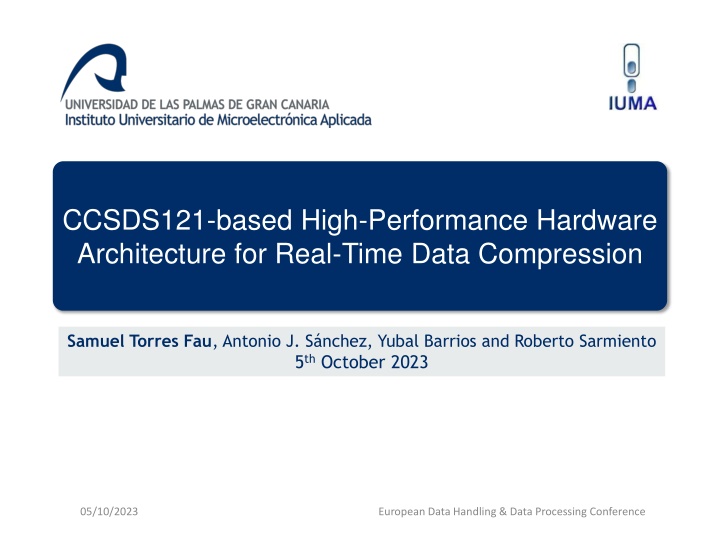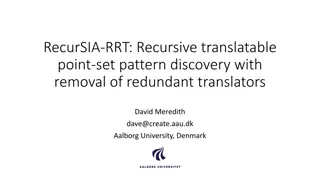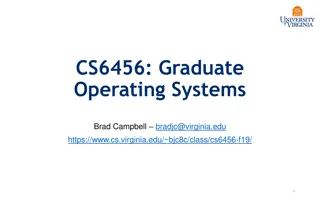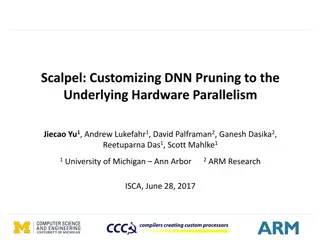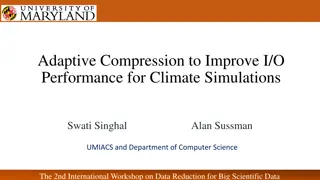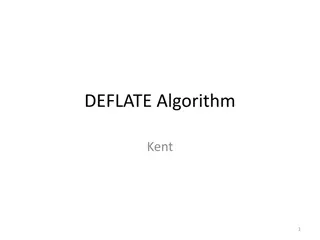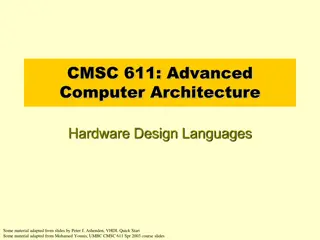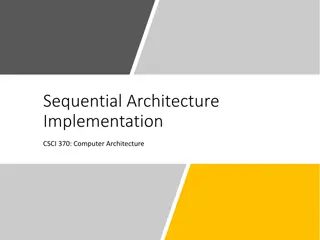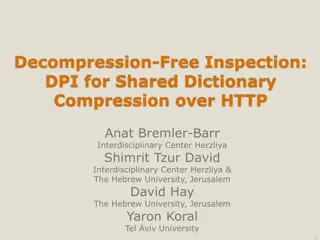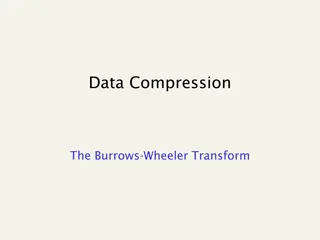High-Performance Hardware Architecture for Real-Time Data Compression
This presentation discusses the development of a high-performance hardware architecture for real-time data compression using CCSDS121-based algorithms. The need for on-board compression in satellite missions, challenges faced, existing compression algorithms, and the main objective of creating a parallel CCSDS 121.0-B-3 Compressor are explored.
Uploaded on Feb 21, 2025 | 3 Views
Download Presentation

Please find below an Image/Link to download the presentation.
The content on the website is provided AS IS for your information and personal use only. It may not be sold, licensed, or shared on other websites without obtaining consent from the author.If you encounter any issues during the download, it is possible that the publisher has removed the file from their server.
You are allowed to download the files provided on this website for personal or commercial use, subject to the condition that they are used lawfully. All files are the property of their respective owners.
The content on the website is provided AS IS for your information and personal use only. It may not be sold, licensed, or shared on other websites without obtaining consent from the author.
E N D
Presentation Transcript
CCSDS121-based High-Performance Hardware Architecture for Real-Time Data Compression Samuel Torres Fau, Antonio J. S nchez, Yubal Barrios and Roberto Sarmiento 5thOctober 2023 European Data Handling & Data Processing Conference 05/10/2023
Contents Introduction and motivation Context and background Architecture Verification and synthesis Conclusions 05/10/2023 European Data Handling & Data Processing Conference 2
Why is on-board compression needed? On-board Compression Introduction EO Mission Compressed data Original data Downlink Earth decompression The number of sensors included in satellites and the resolution of the captured information are continuously increasing Higher data processing throughput and longer transmission periods. Additional challenges Available hardware resources are scarce Limited power Transmission links are slow On-board compression rises as a solution European Data Handling & Data Processing Conference 3 05/10/2023
Problem Modern on-board cameras Data throughputs up to 8 Gbps or even higher Its is crucial to minimize the data storage size and/or the transmissions times Lossless compression is commonly preferred Already existing data compressors can t handle these throughputs. SHyLoC 121.0 ~2.6 Gbps (~160 MHz) SHyLoC 123.0 ~2.5 Gbps (~150 MHz) Development of a new high-performance data compressor Minimize hardware occupancy Parallel processing European Data Handling & Data Processing Conference 5 05/10/2023
CCSDS Compression Algorithms Available CCSDS (Consultative Committee for Space Data Systems) data image compression algorithms) Introduction CCSDS 121 Lossless universal data compression based on Rice coding CCSDS 122 2D Compression based on DWT transform CCSDS 123 Multi and hyperspectral image compression based on prediction European Data Handling & Data Processing Conference 6 5 05/10/2023
Main objective Introduction Development of a parallel, high-performance CCSDS 121.0-B-3 Compressor Why using a universal compression algorithm for image compression? Low complexity algorithm Less hardware occupancy Allows FPGAs to support multiple subsystems running simultaneously High throughput Modern sensors may generate data throughputs of multiple Gbps Acceptable compression rate ~2x lossless compression Compliant with standard decompressors European Data Handling & Data Processing Conference 7 05/10/2023
Contents Introduction and motivation Context and background Architecture Verification and synthesis Conclusions 05/10/2023 European Data Handling & Data Processing Conference 8
CCSDS 121.0 Block-Adaptive entropy coder The optimal coding option is applied to whole J- sample blocks J is a configurable parameter (8, 16, 32, 64) 1 block -> Coded Data Set (CDS) except for Zero-Block CDS All coding options are based on the Rice coding technique Subset of Golomb codes Hardware-efficient thanks to exclusively use of powers of 2 operations Background European Data Handling & Data Processing Conference 9 05/10/2023
CCSDS 121.0 Block-Adaptive entropy coder Unit-Delay Predictor Optional prediction stage Each element predicted with the previous one The differences of each consecutive pair of samples are calculated The predicted residuals are mapped into unsigned values and forwarded to the coding stage Periodic insertion of reference samples Helps to limit potential information losses Simple predictor But somewhat limited Background European Data Handling & Data Processing Conference 10 05/10/2023
SHyLoC IP Cores Compression IP Cores developed by IUMA SHyLoC CCSDS 121.0-B-3 Compressor Core SHyLoC CCSDS 123.0-B-1 Compressor Core Multi- and hyperspectral lossless compression Various possible configurations Standalone Tandem Background SHyLoC CCSDS 121.0-B-3 is the baseline architecture of the proposed design The original pipeline has been deeply modified Both the predictor and entropy coder have been parallelized European Data Handling & Data Processing Conference 11 05/10/2023
Contents Introduction and motivation Context and background Architecture Verification and synthesis Conclusions 05/10/2023 European Data Handling & Data Processing Conference 12
Developed Architecture Predictor Unit-Delay: The 4 received samples are predicted in parallel Architecture Post-Predictor Dispatcher: Builds complete blocks by accumulating the mapped residuals received from the predictor and dispatches these to the lanes. Block-Adaptive entropy coder: Encodes the J-Sample blocks and progressively builds the unified output bitstream by gathering information from all the processing lanes. European Data Handling & Data Processing Conference 13 05/10/2023
Developed Architecture Operation-based control scheme Architecture Whenever the coding option that will be applied to a block is known, an operation, that contains the minimum information needed to consolidate the corresponding CDS, is generated. The coordination of the different processing lanes is significatively eased. The generation of Zero-Block CDS is centralized and included in the operation scheme. Scalability Architecture designed to be scalable. Introduced generics in the VHDL description to ease the implementation of high-performance architectures. European Data Handling & Data Processing Conference 14 05/10/2023
Architecture: Post-Predictor Dispatcher 4 mapped residuals ( block) are received from the predictor Architecture These are stored in a cyclic manner When a complete block is formed (every 2 cycles), this is forwarded to a basic coding lane Key component Communicates blocks that have been parallelized following different methodologies Prediction: block is predicted in parallel (4 samples/cycle) Encoding: Whole blocks are sequentially processed (1 sample/cycle per coding lane) European Data Handling & Data Processing Conference 15 05/10/2023
Architecture: Block-Adaptive Encoder Basic coding lanes process blocks sequentially, through 4 well differentiated stages: 1. CDS Length calculation and Coding Option Selection Architecture 2. CDS Codification 3. CDS Intermediate Reconstruction nFSM3 y CDS Builder nFSM3z y Zero Block Builder 4. CDS Retirement FSM4, Reorder Unit y Retirement Unit 6 parallel processing lanes 4 basic coding lanes Includes all stages Scalable 1 Zero-Blocks coding lane Stages 3* and 4 1 header insertion coding lane European Data Handling & Data Processing Conference 16 05/10/2023
Contents Introduction and motivation Context and background Architecture Verification and synthesis Conclusions 05/10/2023 European Data Handling & Data Processing Conference 17
Verification Verification The verification was carried out in two different phases Block-Level verification Specific testbench developed to verify individual components/blocks: Custom drivers, monitors and scoreboards Unit-Delay Predictor and Post-Predictor Block Dispatcher verified following this methodology System-wide verification Performed once the system was fully described and integrated Large verification campaign European Data Handling & Data Processing Conference 18 05/10/2023
System-wide Verification Verification of the complete architecture, Gray Box testing Verification Instead of individually checking the internal components, demonstrate that the whole system behaves as expected Check of IP status signals Output bitstream correctness check If any problem arises, a more in-depth analysis of the behavior is performed 3 groups of testcases simulated: G1 basic tests: reduced set of compression runs with synthetic images G2 intentional tests: set of tests specifically aimed at stimulating specific, less-common parts of the design G3 functional tests: compression of real, large images 19 European Data Handling & Data Processing Conference 05/10/2023
Synthesis results Once verified, the architecture was synthesized Synthesis Xilinx Kintex Ultrascale XCKU040 No vendor-specific libraries used Technology-agnostic architecture Obtained synthesized results: CDS Retirement is the most critical part CDS Reorder & Retirement Units use ~40% LUTs System clock critical path located inside FSM4 Frequency of 121.5 MHz 7.8 Gbps maximum input throughput 21 European Data Handling & Data Processing Conference 05/10/2023
Synthesis results Comparison against original 121.0 SHyLoC: Synthesis Resource SHyLoC 121.0-B-3 Parallel121 System clock (MHz) 160.2 121.5 Throughput (Gbps) 2.56 7.78 I/O Ports 204 378 Block RAMs - - LUTs 3708 28329 FFs 1560 8774 DSPs 4 4 3x throughput increase Hardware occupancy increases as well due to the inclusion of multiples lanes Generation of a unified bitstream has a significant impact 22 European Data Handling & Data Processing Conference 05/10/2023
Contents Introduction and motivation Context and background Architecture Verification and synthesis Conclusions 05/10/2023 European Data Handling & Data Processing Conference 23
Conclusions VHDL performance, parallel compressor system. Design and verification of a CCSDS 121.0-B-3 high- Both prediction and codification blocks parallelized Operation-based control scheme Effectively removes the Zero-Blocks dependencies Coordination of the coding lanes is a centralized mechanism Unified bitstream generation Scalable architecture Duplication of the basic coding lanes Architecture verified through two different verification campaigns Synthesis results demonstrate the viability of the solution Minimal hardware resource occupancy (~11% LUTs, ~2% FFs, 4 DSPs, No BRAMs) System clock 121.5 MHz, 7.8 Gbps 24 European Data Handling & Data Processing Conference 05/10/2023
CCSDS121-based High-Performance Hardware Architecture for Real-Time Data Compression Samuel Torres Fau, Antonio J. S nchez, Yubal Barrios and Roberto Sarmiento 5thOctober 2023 European Data Handling & Data Processing Conference 05/10/2023
